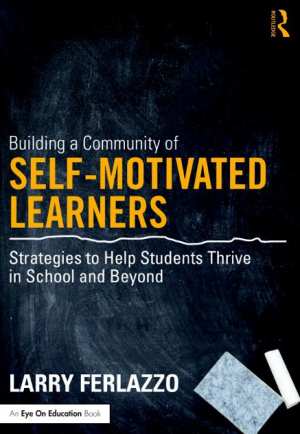What Motivates A Student’s Interest in Reading and Writing

The excerpt below is from the book “Building a Community of Self-Motivated Learners: Strategies to Help Students Thrive in School and Beyond,” by Larry Ferlazzo. This excerpt is from the chapter entitled “I Still Want to Know: How Can You Get Students More Interested in Reading and Writing?”
Let’s begin with a review of those essential qualities (needed to develop intrinsic motivation) in the context of reading and writing:
♦ Autonomy. A major Pew Research Center report (Lenhart et al., 2008) found that choice has an equally important role in teens feeling a desire to write (the story in Chapter 1 of my student who was energized by writing about football illustrates this point). Likewise, in reading, extensive research documents that teachers encouraging students to read books of their choice for pleasure is a major contribution towards students developing a positive attitude towards reading and a life-long interest in it (Leisure Reading Task Force, 20014, p. 2).
 ♦ Competence. A scene from the HBO series The Leftovers (http:// www.hbo.com/the-leftovers) succinctly explains why this quality is so important for intrinsic motivation. In it, two FBI agents were sitting in an office, and one told the other that his child wanted to quit soccer and wanted to know if he should let him do it. The other agent asked him, “Is he any good at it?” The first agent responded, “Nobody quits what they’re good at,” and much research backs him up (Tsioulcas, 2013; Yuhas, 2012). Providing scaffolding like writing frames and strategies/tools such as graphic organizers (student- or teacher-created) for responding to prompts (Ferlazzo, 2013, p. 144) can assist students’ developing confidence as writers. The Progress Principle, which highlights that intrinsic motivation can be driven by people seeing meaningful progress in their work, was mentioned in the first chapter and in previous titles in this series (Ferlazzo, 2013, p. 10). Creating structured opportunities for students to see their progress in reading and writing by comparing work (preferably emphasizing tools like “improvement rubrics” that focus more on what they have successfully done and less on their deficits [Ferlazzo, 2011, p. 79]) done at the beginning of the school year with accomplishments later in the year can also support student feelings of competence. In fact, at our school English folders are passed up through the grades and students can see and reflect on their progress over the years!
♦ Competence. A scene from the HBO series The Leftovers (http:// www.hbo.com/the-leftovers) succinctly explains why this quality is so important for intrinsic motivation. In it, two FBI agents were sitting in an office, and one told the other that his child wanted to quit soccer and wanted to know if he should let him do it. The other agent asked him, “Is he any good at it?” The first agent responded, “Nobody quits what they’re good at,” and much research backs him up (Tsioulcas, 2013; Yuhas, 2012). Providing scaffolding like writing frames and strategies/tools such as graphic organizers (student- or teacher-created) for responding to prompts (Ferlazzo, 2013, p. 144) can assist students’ developing confidence as writers. The Progress Principle, which highlights that intrinsic motivation can be driven by people seeing meaningful progress in their work, was mentioned in the first chapter and in previous titles in this series (Ferlazzo, 2013, p. 10). Creating structured opportunities for students to see their progress in reading and writing by comparing work (preferably emphasizing tools like “improvement rubrics” that focus more on what they have successfully done and less on their deficits [Ferlazzo, 2011, p. 79]) done at the beginning of the school year with accomplishments later in the year can also support student feelings of competence. In fact, at our school English folders are passed up through the grades and students can see and reflect on their progress over the years!
♦ Relatedness. The Pew Research Center found that teens say the most important factor for them to feel motivated to write is using it as a way to connect with, and receive feedback from, teachers, family members, and friends (Lenhart et al., 2008). Opportunities for students to discuss what they are reading with their teachers and with their peers in low-or-no-stakes environments has been found to promote a greater interest in reading (Leisure Reading Task Force, 2014, p. 4).
♦ The work is seen as interesting, and valuable for future goals. In other words, as mentioned in Chapter 1, students should see it as relevant to their present lives and/or hopes and dreams for the future.
A slight “qualifier” should be attached to the second part of this last element— the one about it being seen as helpful to hopes and dreams for the future. As mentioned in Chapter 1, some researchers suggest that teachers explicitly pointing out how skills being taught in the classroom can be used in the future by students can be damaging to intrinsic motivation, particularly if they do not feel confident in their abilities or have little interest in the subject (Hulleman et al., 2010, p. 881). This issue is particularly relevant to a discussion on reading and writing since a significant percentage of students, particularly boys, often say that English is not a favorite subject (Wiggins, 2014) and multiple surveys have found that decreasing percentages of young people say they enjoy reading (Leisure Reading Task Force, 2014, p. 3). As a result of these negative attitudes, many of us teachers may tend to use a motivational strategy of emphasizing to students how important literacy will be to any of their future goals (Ferlazzo, 2013, p. 147).
Is this a bad strategy? The slightly “qualified” answer is yes, no, and possibly maybe . . . Other researchers also suggest that we need to be particularly careful when we focus on relevance towards a student’s goals, though they also see potential benefits. Motivation researchers Edward Deci and Richard Ryan call slightly different versions of it “regulation through identification” and “integrated regulation.” They believe the motive of wanting to do something less for the joy it brings and more for its instrumental value towards achieving a goal is a less harmful form of extrinsic motivation that—on a continuum—is as close as you can get to intrinsic motivation without being there (Ryan & Deci, 2000, p. 61). They also point out, however, that its promotion can still bring many benefits, including greater engagement and learning as well as increasing the potential that those tasks can be moved to the final step of intrinsically motivated, as long as the other three elements—autonomy, competence, and relatedness—are present (Ryan & Deci, 2000, pp. 63, 65). Indeed, organizers of the 2012 international PISA test in 2012 found that, over the previous ten years, countries where students reported an increase in intrinsic motivation also reported an increase in students reporting this kind of instrumental motivation (Organization for Economic Cooperation and Development [OECD], 2012, p. 74).
So, what does this “qualifier” mean practically for our classroom practice? Is it a group of academicians arguing about how many angels can dance on the head of a pin (What’s the historical origin, n.d.)? Or is it a meaningful nuance we should seriously consider?

I would suggest that teachers explicitly connecting what is being taught in school to student goals—by pointing it out themselves or by drawing it out of students (which, as Chapter 1 pointed out, appears to have less damaging potential)—can have a place in class, but also has to be kept in its place. In my experience, we will get fewer “Why are we learning this?” questions in learning environments that promote autonomy, competence, relatedness, or are connected to student interest. But when we do, I don’t see anything wrong in helping students make those connections to their personal and professional goals or periodically having teacher- initiated lessons with that focus, such as several in this book and in previous ones (Ferlazzo, 2013, p. 147). On the other hand, constantly getting “Why are we learning this?” or “How are we going to use this?” questions might be an important indicator that we are not doing as good a job as we could be on implementing those other important conditions necessary for the development of intrinsic motivation.
Larry Ferlazzo is an award-winning teacher at Luther Burbank High School in Sacramento, California. He writes a popular education blog and a teacher advice column for Education Week Teacher. You can follow him on Twitter at @Larryferlazzo.





